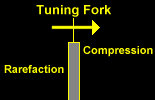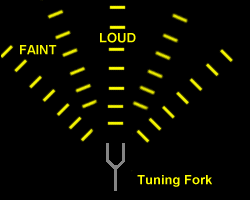



|
When two or more sets of sound waves pass through each other, the resulting amplitude of the vibrating air molecules is the sum of the individual waves' amplitudes (PRINCIPLE OF SUPERPOSITION)
When the resulting amplitude is small, the sound is faint, and vice versa. When the interference creates large amplitude, the sound is louder.
When the interference is destructive, compressions from one source meet rarefactions from the other source, the resulting sound is faint. When the interference is constructive, the sound is louder.


The tine emits two sets of waves with the SAME frequency. As the waves travel out, they interfere with each other. In some regions, the interference is destructive, which produces a faint sound. In other regions, the interference is constructive, resulting in a louder sound.

The interference pattern produced by a vibrating tuning fork.
If two sets of sound waves with different frequencies interfere, they are alternately in step (sound is loud) and out of step (sound is faint). This periodic increase and decrease in loudness is called the phenomenon of beats

The beat frequency is equal to the difference of the two frequencies producing the beats.
Only if the beat frequency is not to high, that is the two frequencies producing them differ slightly.
 Here is an example of the Production of Beats.
Here is an example of the Production of Beats.
Example: 130 Hz and 128
Hz or 132 Hz produce two beats per second (130 +/- 2).
Demonstration:
- One tine on one fork has a paper clip on it, this slows it down, creating beats.
- Both forks must be played at the same time in order to hear the beats.
The number of maximum intensity points that occur per second is called the beat frequency. The formula to find the beat frequency is as follows:
| BACK TO TOP |


|